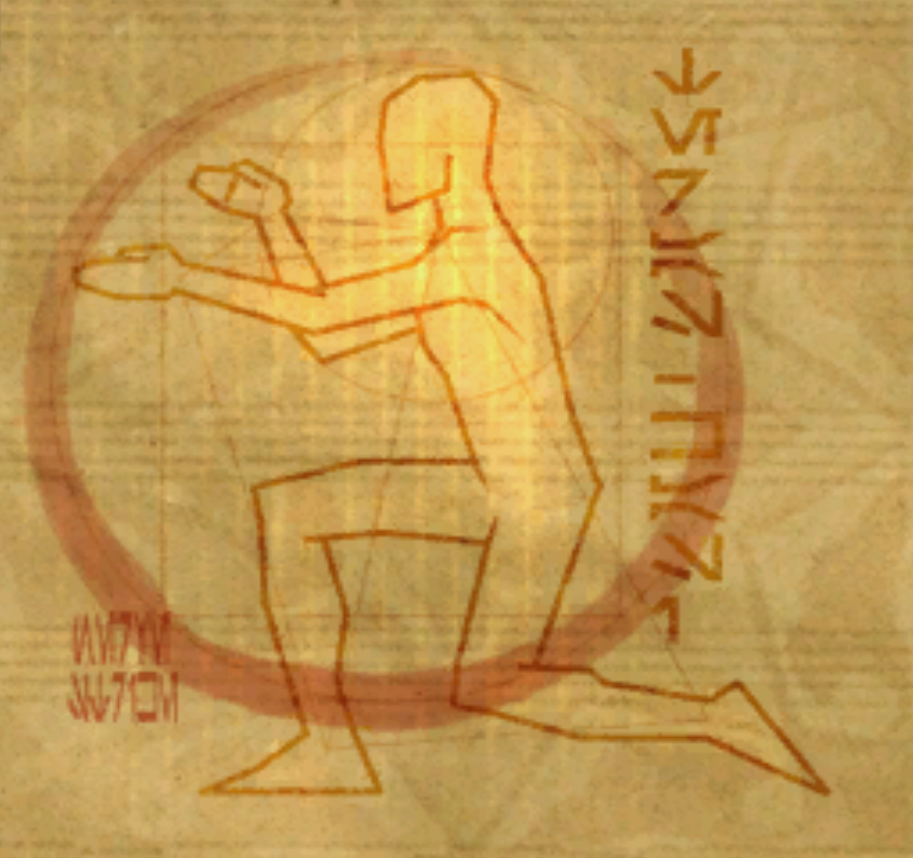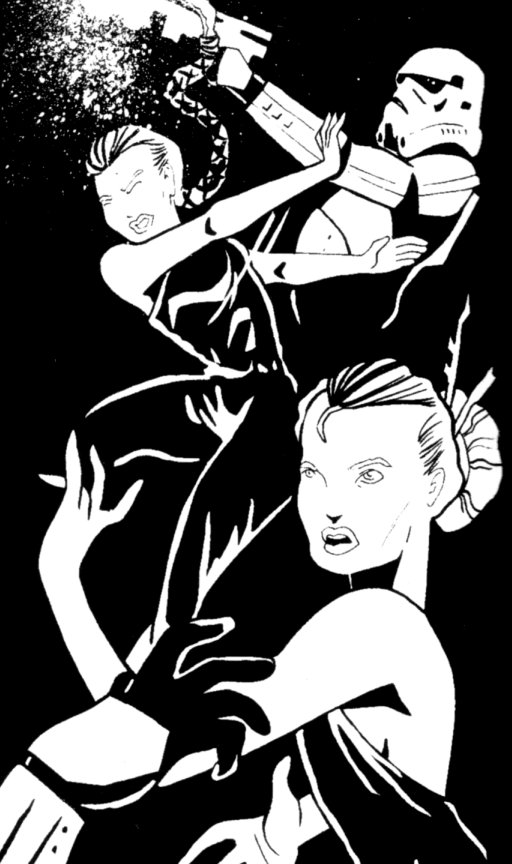Teräs Käsi, or "steel hand" in Basic, was a deadly and mystical martial art discipline renowned throughout the galaxy for its lethality.
Teräs Käsi originated in the remote star cluster of the Pacanth Reach on the world of Bunduki, which was populated by the near-human species known as the Epicanthix. On Bunduki, the secretive Followers of Palawa developed Teräs Käsi solely to fight with Jedi; their homeworld of Palawa was devastated in a war involving the Jedi Council, and the Followers developed the deadly martial art to ensure that another world would never be destroyed by the actions of the Council.
To learn Teräs Käsi, students were often sent to learn directly from the Followers, where students were taught about history, literature, metaphysics, and the philosophies of the Pacanth Reach cultures, with the Followers encouraging students to use the art for the good and betterment of society. Many who learned the secrets of Teräs Käsi brought the knowledge to other corners of the galaxy - though it remained rare enough that to learn Teräs Käsi off of Bunduki, one had to seek out one of these graduate masters.

A Teräs Käsi Defensive Stance detailing a Nerve Strike.
Teräs Käsi practitioners were the undisputed masters of melee combat, their skill and prowess rivaling even that of the Jedi. Utilizing ancient meditative techniques, practitioners were capable of pushing their bodies to supernatural limits, achieving the seemingly impossible by mastering mind over body. Masters of the art used extremely quick and devastating strikes, with many of the moves being so fast that the artist appears to blur with speed.
A deadly and exceedingly lethal martial art, Teräs Käsi actually meant "steel hands" in Basic, referring to the extreme toughness of a practitioner's fists and the heavy piston-like blows they could produce. This reputation was well deserved; masters of Teräs Käsi were known to deliver strikes that rivaled slugthrowers and blaster pistols in terms of power, easily punching through body armor, with even novitiates capable of surprising damage - though to a somewhat lesser degree. Further, intense training in Teräs Käsi could develop a blinding speed and tune the senses so accurately that a practitioner could anticipate strikes with an uncanny ease, being able to dodge so quickly that they appeared as a blur. As a result, practitioners also had a high degree of acrobatics; a falling practitioner could use midair acrobatics to direct their fall and avoid striking ledges and other potentially lethal obstructions.
These feats of strength, speed, and acrobatics were made possible due to the central tenets of Teräs Käsi, mainly control and mastery of one's self, to the point that a practitioner had complete control over their body. Teräs Käsi also incorporated meditative arts, turning a Teräs Käsi artist's mental control inwards rather than outwards; practitioners could enter an immobile meditative trance-like state and stop bleeding, as well as slow poisons and diseases - master meditation artists were even able to slowly heal their own wounds by channeling their mental energies back into themselves. As a martial art, Teräs Käsi was patterned after the movements and hunting characteristics of various beasts throughout the galaxy, with many moves being named after these movements - such as Charging Wampa, Rancor Rising, and Dancing Dragonsnake to name a few. Teräs Käsi emphasized close work, utilizing hands, feet, elbows, blades, and sticks, with half a dozen basic stances that relied on four ranges of engagement; kicking, punching, elbowing, and grappling range.

The Pike sisters: Zan and Zu, masters of Teräs Käsi
Lending to its initial creation as a weapon against Jedi, Teräs Käsi was exceedingly lethal, and allowed dedicated practitioners an incredibly high degree of combat skill. For example, the non-forceful pike sisters defeated over two dozen armed combatants single-handedly using only Teras Kasi, ultimately refusing to use weapons, and were fully capable of taking out squads of opponents armed with blasters.
Phow Ji, a non-forceful Human mercenary and Teräs Käsi practitioner from Bunduki singlehandedly engaged a large group of Salissian mercenaries and battle droids, showing immense martial ability in the process, and was capable of drawing his weapons so fast that they seemed to simply appear in his hands, firing his blaster so accurately as to shoot his opponents blasters out of their hands, and largely avoiding blaster fire from dozens of infantry with acrobatic leaps, feints, and dodges described as "Jedi-like".
Some lightsaber duelists used Teräs Käsi techniques in combat, most notably Darth Maul, who trained extensively in the art and incorporated it into his lightsaber and unarmed techniques - Maul credited the martial art as one of the primary reasons he was so successful and deadly as an assassin. Paradoxically, many Jedi also studied Teräs Käsi, including Jedi Master Anoon Bondara, Jedi Knight Joclad Danva, and Jedi Master Plo Koon.
- Aryx slash was named after the aryx of Cerea.
- Charging Wampa was named after the Wampa of Hoth. The move involved charging at your opponent, attempting to hit them in the jaw, followed by a simultaneous hit of both arms on the opponent's neck.
- Dancing Dragonsnake was named after the Dragonsnake of Dagobah.
- Death Weave
- Förräderi
- Gorax smash was named after the gigantic gorax species.
- Gronda stomp was named after the Corelliangronda.
- Gundark slap was named after the gundark species.
- Leaping veermok was named after the leaping movement of the veermok.
- Nerve strike
- Nexu Grin was named after the nexu of Cholganna.
- Rancor Rising was named after the rancor of Dathomir.
- Riding Bantha was named after the beast of burden of the same name.
- Screaming squill was named after the scream of the squill.
- Shenbit bonecrusher blow was named after the shenbit bonecrusher.
- Slashing Wampa was named after the wampa of Hoth.
- Sleeping krayt was named after the dangerous krayt dragon.
- Spitting Rawl was reputed to be the most powerful attack in the arsenal of unarmed combat techniques belonging to a Teräs Käsi Master. It consisted of a sideways flip, bringing one's feet down on the opponent three times before bashing with both fists at the same time in a vertical fashion.
- Steel hands was a technique which was eponymous with the martial art itself.
- Striking Sarlacc was named after the dreaded Sarlacc.
Teräs Käsi is inspired by a real-life fighting style called pencak silat, with the word Teräs Käsi coming from the real world Finnish language. Translated word for word in Finnish, Teräs Käsi means "steel hand" as opposed to the plural "steel hands" - this has been retconned in canon somewhat by having sources say both "hand" or "hands". The name Teräs Käsi meaning "steel hand" is an allusion to the video game series Tekken by Namco, which was a direct source of inspiration for the video game Star Wars: Masters of Teräs Käsi. In Steve Perry's novel The Musashi Flex, a prequel to his Matador book series, Teräs Käsi is briefly mentioned as one of the fighting styles practiced by the novel's main character.
- Star Wars: Tiny Death Star